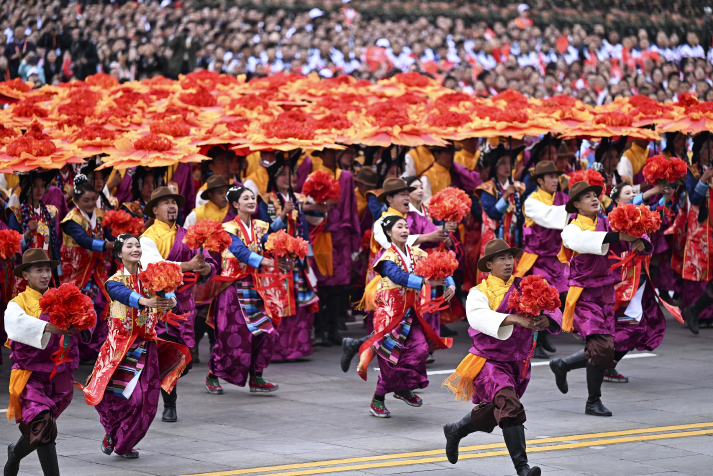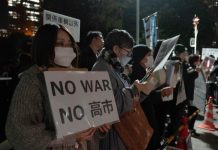
On August 25, Tarob Yonden Tsomo was busy at her café in Lhasa, capital of Xizang Autonomous Region, working from early morning until late at night. “Today is the Shoton Festival holiday, so the café is even busier—I’ve been working nonstop,” she told Beijing Review.
Originating in the middle of the 11th century, the Shoton Festival, also known as the Yogurt Festival, is celebrated mainly in Lhasa. It was among the first to be inscribed on China’s national list of intangible cultural heritage in 2006. During the festival, local residents enjoy yogurt, go on elaborate picnics and attend traditional activities such as Tibetan Opera and horse racing.
Tarob Yonden Tsomo’s coffee chain is called Nindo, which means “best friends” in Tibetan. “We created the brand in 2018 and now have five stores in Lhasa, all specializing in Tibetan-style coffee,” she said. Their signature drinks incorporate local ingredients such as yak milk curds, butter and highland barley popcorn, offering a unique blend of traditional flavors and modern coffee culture. Highland barley is the staple crop of the Qinghai-Xizang Plateau.
This May, Nindo joined the London Coffee Festival together with several other Chinese coffee brands. Their Tibetan-style coffee proved incredibly popular, attracting many visitors eager to take a sip. “Many people associate Xizang with beautiful natural scenery and a profound cultural heritage. I hope that through coffee—a relatively new medium—more people will gain a deeper understanding of Tibetan culture,” Tarob Yonden Tsomo added.
Dustin Wang, a Beijing-based trader who visited Xizang in August, shared Tarob Yonden Tsomo’s view, “Xizang isn’t just about history; it has a pulsating modern culture, too. In Lhasa, you’ll find hundreds of coffee shops, bars, live music venues and more—much like any other Chinese city,” Wang said.
“I first went to Xizang in 2021, and many things have changed since then. Lhasa’s urban area, for instance, has expanded considerably,” Wang told Beijing Review.
Transformations and modernization are the main topics when media cover issues in China, and Xizang, as one of the country’s autonomous regions, is no exception.
An autonomous region is a provincial-level administrative division of China. China has five such regions: Guangxi Zhuang, Inner Mongolia, Ningxia Hui, Xizang and Xinjiang Uygur.
Regional ethnic autonomy is a basic political system of China, and it is a cornerstone in China’s approach to addressing ethnic issues. It means that, under the unified leadership of the state, regional autonomy is practiced in areas where ethnic minorities live in compact communities. In these areas, self-government organs have been established to exercise autonomy.
This year is the 60th anniversary of the founding of Xizang Autonomous Region. Following its peaceful liberation in 1951 and the epoch-making democratic reform initiated in 1959, the autonomous region was officially established in September 1965. This was a historic transition from feudal serfdom to a socialist society characterized by people’s democracy, opening a new chapter in its development.

Ongoing construction
“In recent years, Xizang has seen tremendous changes. For example, transportation in Lhasa has become increasingly convenient—it used to take more than two hours to get to the airport, but now it only takes about one hour, and the number of residents in the city has also grown fast,” Tarob Yonden Tosom said.
Continuous improvements in infrastructure serve as typical examples of a region’s transformation.
Xizang, once isolated and inaccessible, became connected to the rest of China with the opening of Sichuan-Xizang and Qinghai-Xizang highways in 1954. Medog, nestled deep in the Himalayan mountain range, was once China’s only county without highway access. In 2013, the 117-km Medog Highway finally ended the county’s isolation, revolutionizing access to transportation, education and healthcare.
The completion and entry into service of the Qinghai-Xizang Railway in 2006 marked the end of the region’s railway-less history. The region’s first electrified railway, the Lhasa-Nyingchi Railway, became operational in June 2021. Traveling at 160 km per hour, the highest speed attainable on the high-altitude plateau, Fuxing high-speed trains serve the 435-km route.
As of late 2024, the total length of roads in Xizang reached 124,900 km, with operational railway lines range at 1,359 km and the number of domestic and international air routes increasing to 183.
Major projects have also seen accelerated progress during the 14th Five-Year Plan (2021-25) period, with a cumulative planned investment exceeding 400 billion yuan ($56 billion) implemented. Construction of the Sichuan-Xizang Railway made important progress while work began on a hydropower project in the lower reaches of the Yarlung Zangbo River.
In a previous interview, José Carlos Feliciano, Deputy Director of the Center for China and Asia-Pacific Studies at Pacific University of Peru, told Beijing Review that he was impressed by the region’s infrastructure, from airports to highways. He said he believes these projects have significantly boosted the development of tourism.
“On Western social media, Xizang is portrayed as a holy land full of temples and history; however, I think it also combines some modern aspects and resources that help tourism to become an important economic activity,” he said.
Galai, a picturesque village in Nyingchi, boasts over 1,000 peach trees. In recent years, rural tourism blossomed into a pillar industry, transforming local livelihoods. Peach blossoms, long revered in Chinese culture as emblems of pastoral beauty, now draw flocks of visitors to Galai each spring for its vivacious festival, aided by the convenience of a nearby highway. This “peach blossom economy” has become a reliable source of local income.
Amid rapid growth in the region’s tourism industry, Xizang received over 63.89 million visits by domestic and international tourists in 2024, up 15.8 percent year on year.

Embracing modernity
With the continuous improvement of infrastructure, economic growth and the deepening of modernization, people’s daily lives have undergone tremendous transformations.
“You can also find many famous consumer brands in Xizang,” Wang said. These include, for example, bubble tea brands Mixue and Heytea, as well as Kentucky Fried Chicken. Wang also noted that 5G service coverage has been achieved almost universally throughout the region.
According to the Human Rights in Xizang in the New Era white paper, which was released by the State Council Information Office on March 28, the 5G wireless network is accessible in every town and township in Xizang. The service had also reached 70 percent of administrative villages in the region by 2024.
“Basically, cutting-edge products and modern services available in other regions are also accessible in Xizang,” Tarob Yonden Tsomo said.
Xizang has seen remarkable improvements in living standards, Gama Cedain, chairman of the regional government of Xizang, told a press conference on August 15.
A series of major livelihood initiatives were implemented during the period. These include introducing centralized heating and oxygen systems in high-altitude areas, resolving seasonal water shortages in pastoral regions and improving the reliability of the electricity supply.
“These improvements have enhanced comfort and convenience in the daily lives of all ethnic groups in the region,” Gama Cedain said.
During the 14th Five-Year Plan period, 24.65 billion yuan ($3.4 billion) was allocated to social development projects in 28 categories, including healthcare, education, social security, culture and sports, he said.
Regional GDP reached 276.5 billion yuan ($38.5 billion) in 2024, 155 times the 1965 number, with an average annual growth rate of 8.9 percent, Wang Junzheng, Secretary of the Communist Party of China Xizang Autonomous Regional Committee, said at the press conference.
Wang noted that while it took the region 50 years to cross the 100-billion-yuan ($14-billion) mark in GDP, the 200-billion-yuan ($28-billion) milestone was surpassed just six years later.
Moreover, in 2024, the per-capita disposable income of urban residents in the region reached 55,444 yuan ($7,741), 121 times that of 1965, with an average annual growth of 8.5 percent. The per-capita disposable income of rural residents came in at 21,578 yuan ($3,012), 199 times that of 1965, with an average annual growth rate of 9.4 percent.
Today, Xizang’s average life expectancy has reached 72.5 years, compared with 35.5 years in the 1950s.
Good governance
The region’s development has received much attention and support from the Central Government—and the country at large. Between 1965 and 2024, the Central Government, for one, allocated 2.6 trillion yuan ($360 billion) in fiscal funding to the region.
A further 64.3 billion yuan ($8.9 billion) has been invested in the region since the early 1990s through the paired-up assistance program, under which 17 provinces and municipalities, central enterprises and financial institutions are paired with cities and counties in Xizang for the purpose of providing development support. Additionally, more than 14,000 officials and professionals have been dispatched in 11 groups to assist Xizang.
Chinese President Xi Jinping visited the plateau region on August 20-21 and joined locals in celebrating six decades of progress since the autonomous region was established. It was the first time that China’s top leader had attended Xizang Autonomous Region’s founding anniversary celebrations.
Xi called on Xizang to continue advancing its four major tasks—ensuring stability, facilitating development, protecting the eco-environment and strengthening frontiers. He called for concerted efforts to build a united, prosperous, culturally advanced, harmonious and beautiful new modern socialist Xizang.
Xi also emphasized the importance of maintaining political and social stability, strengthening ethnic unity, and fostering amity among different religions. He highlighted both the importance of high-quality development for the region as well as the need to develop competitive plateau industries based on local conditions. In consideration of Xizang’s fragile ecology, Xi called on the region to promote ecological conservation, and to make coordinated efforts to cut carbon emissions, reduce pollution, expand green development and pursue economic growth, so as to protect the Roof of the World and the Water Tower of Asia.
Xi underscored the need to coordinate urbanization and rural revitalization—a strategy introduced in 2017 to promote prosperity in rural areas, consolidate poverty eradication gains and achieve progress in employment, education, healthcare and social security across China.
The goal, as he put it, is to enhance the sense of fulfillment, happiness and security for all ethnic groups in the region. –The Daily Mail-Beijing Review News exchange item




